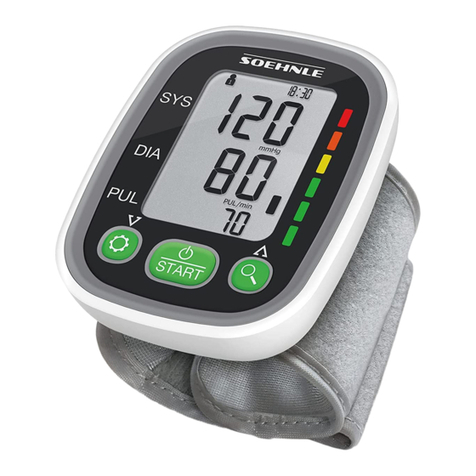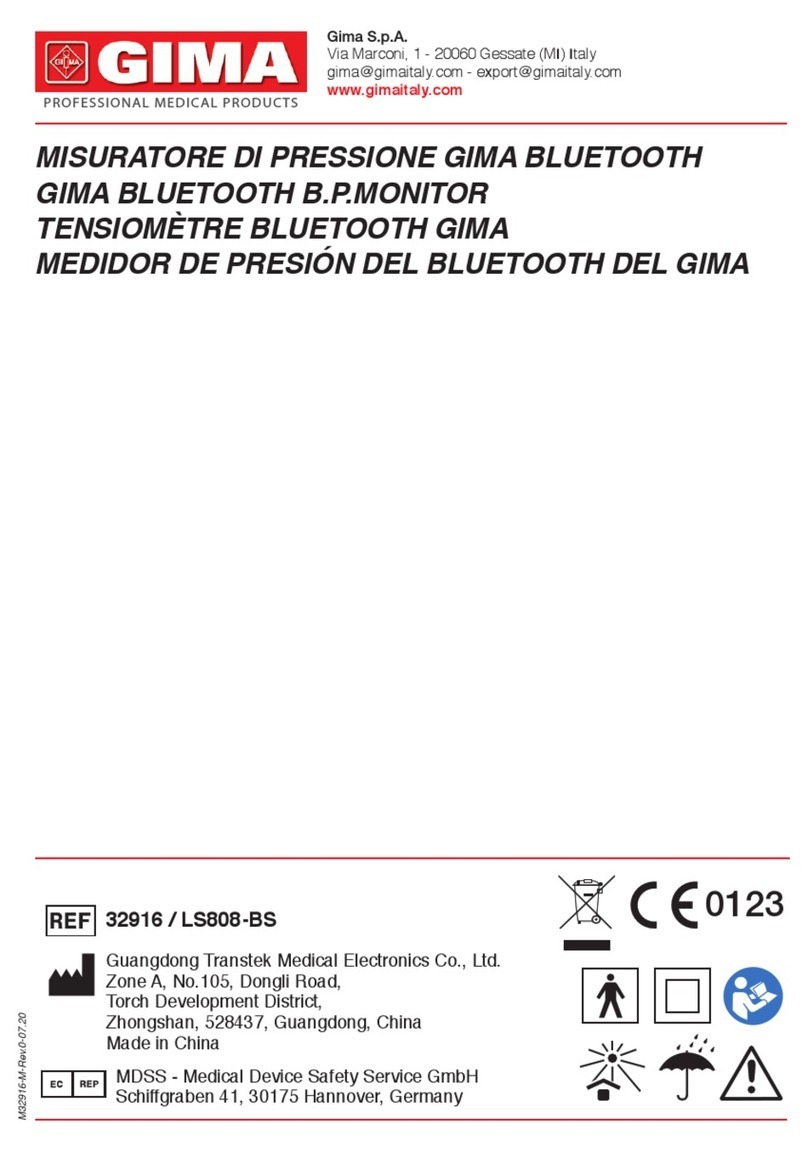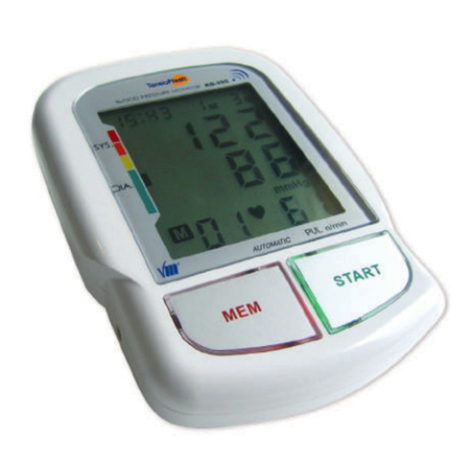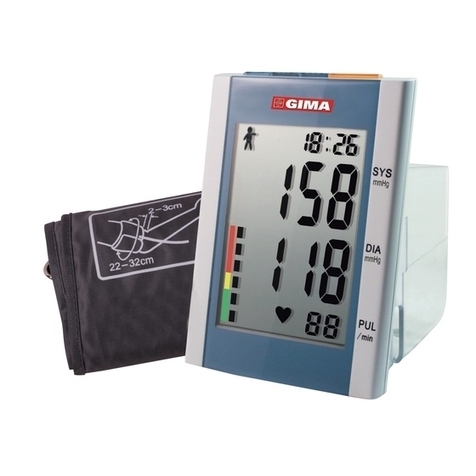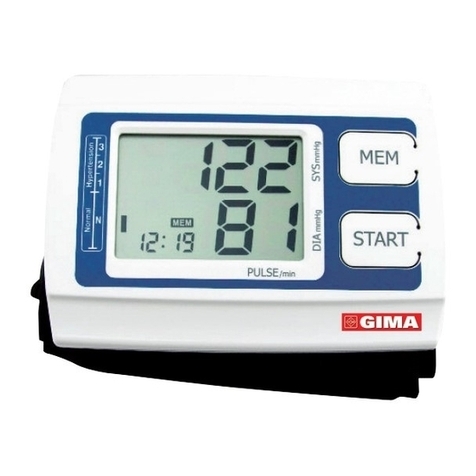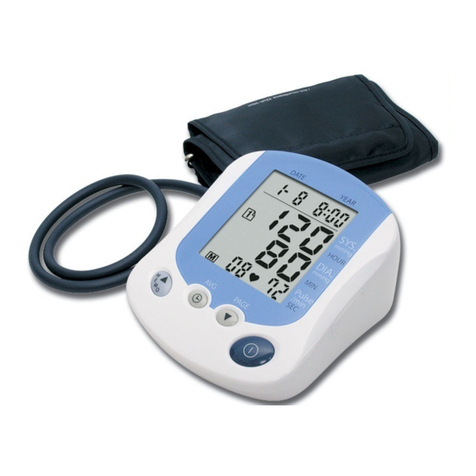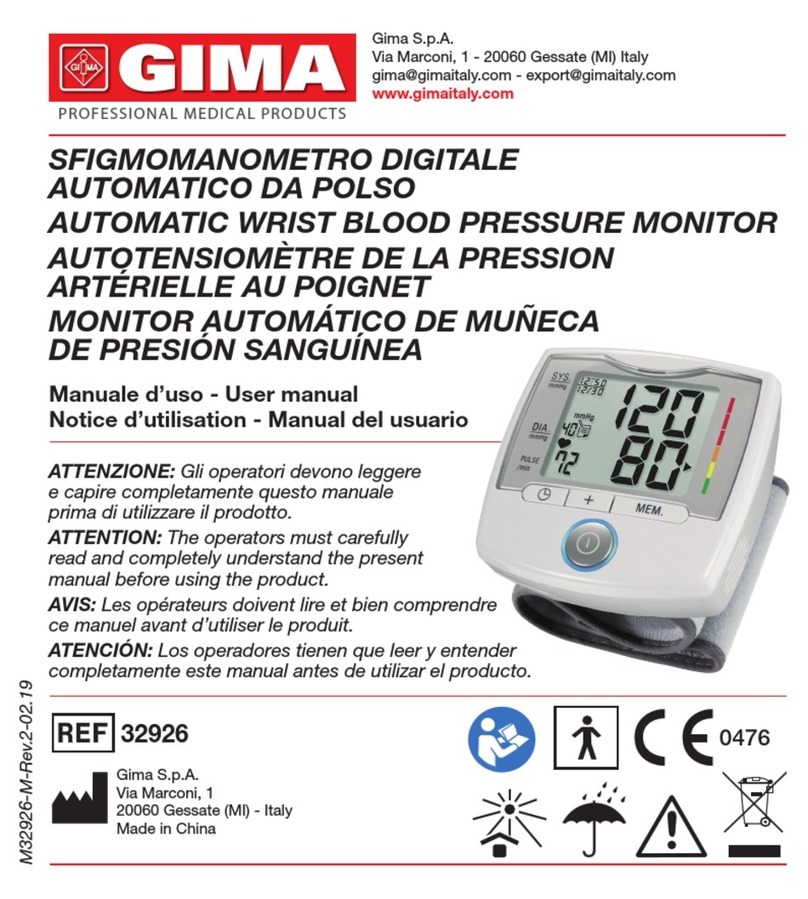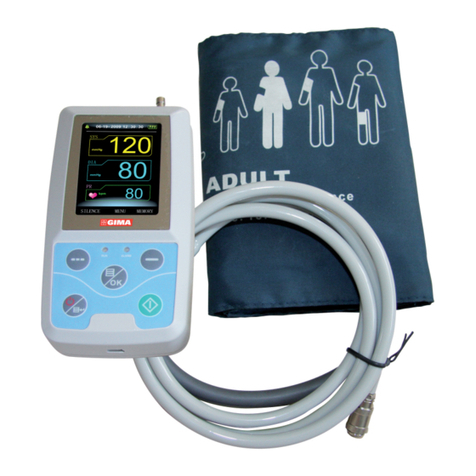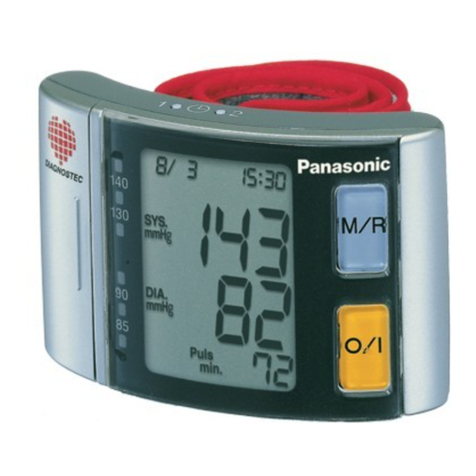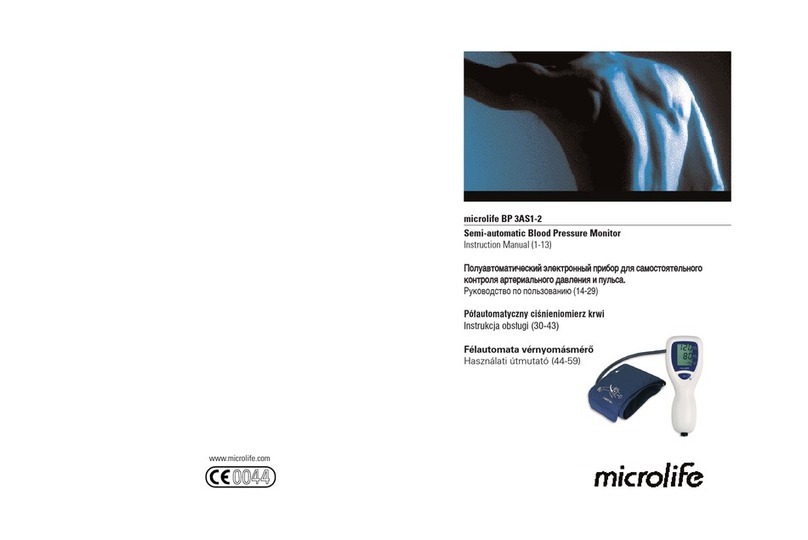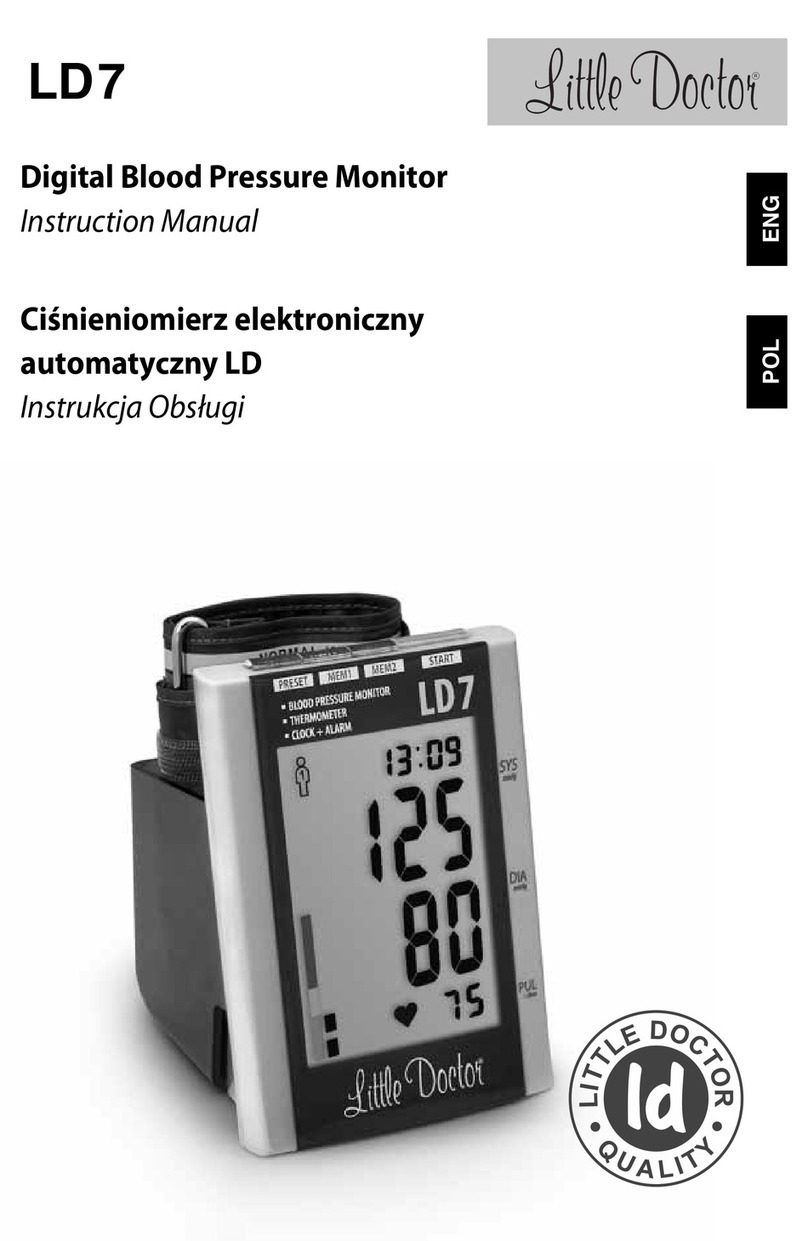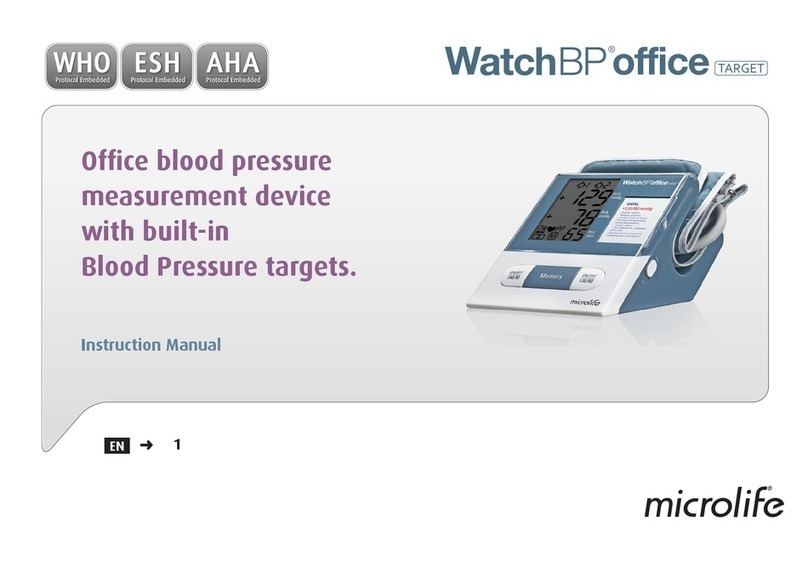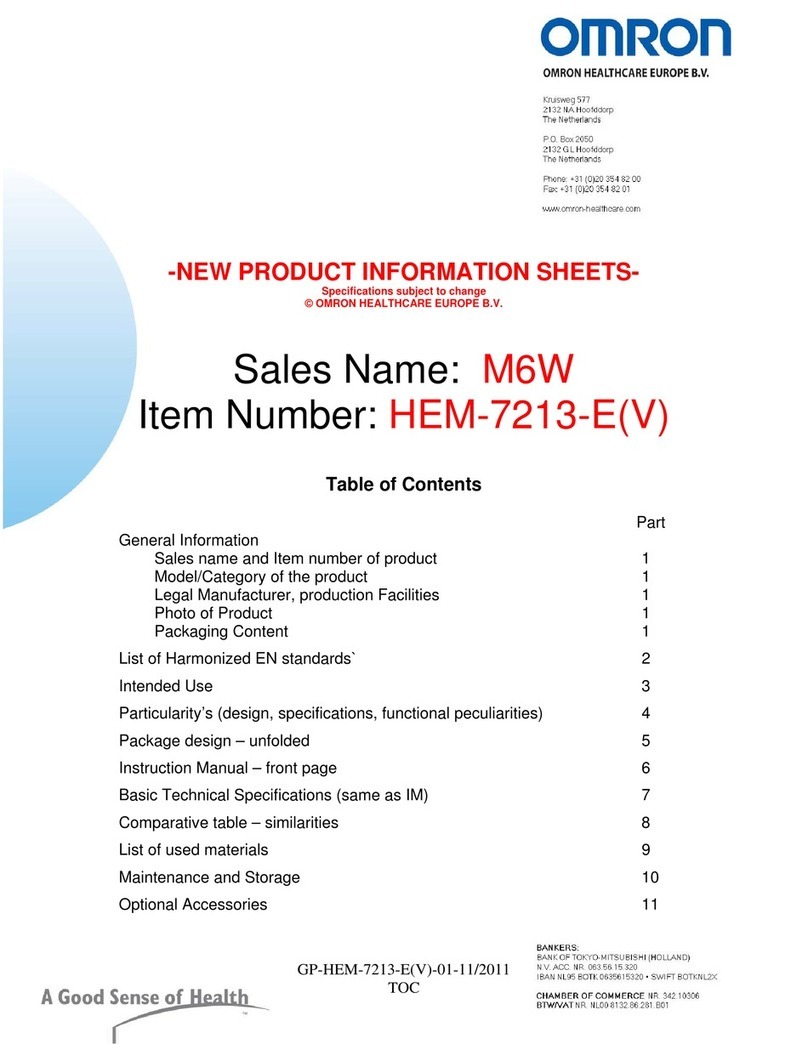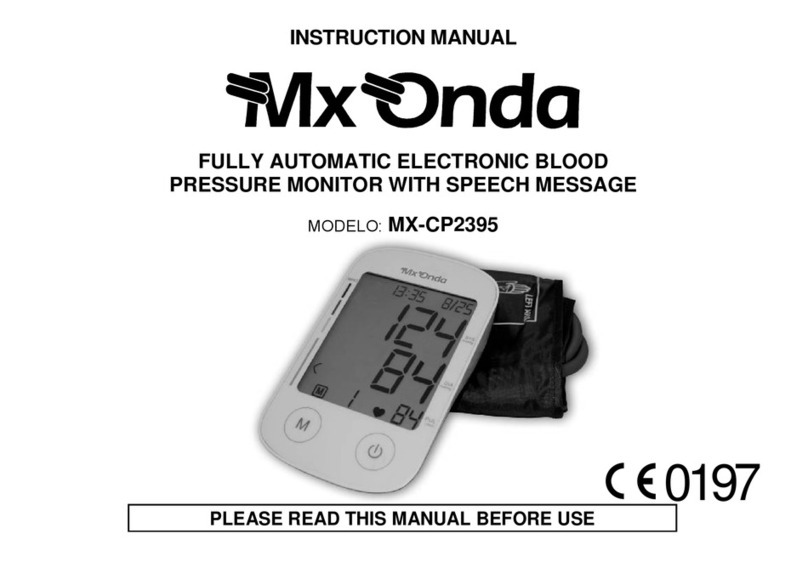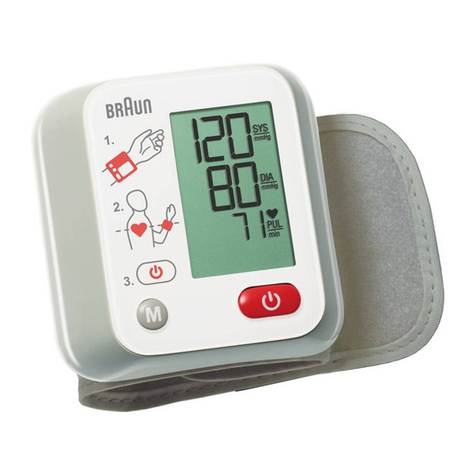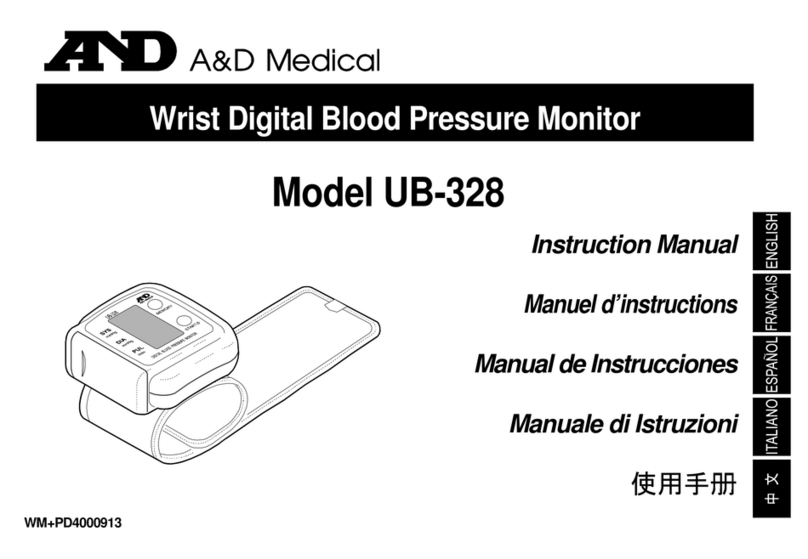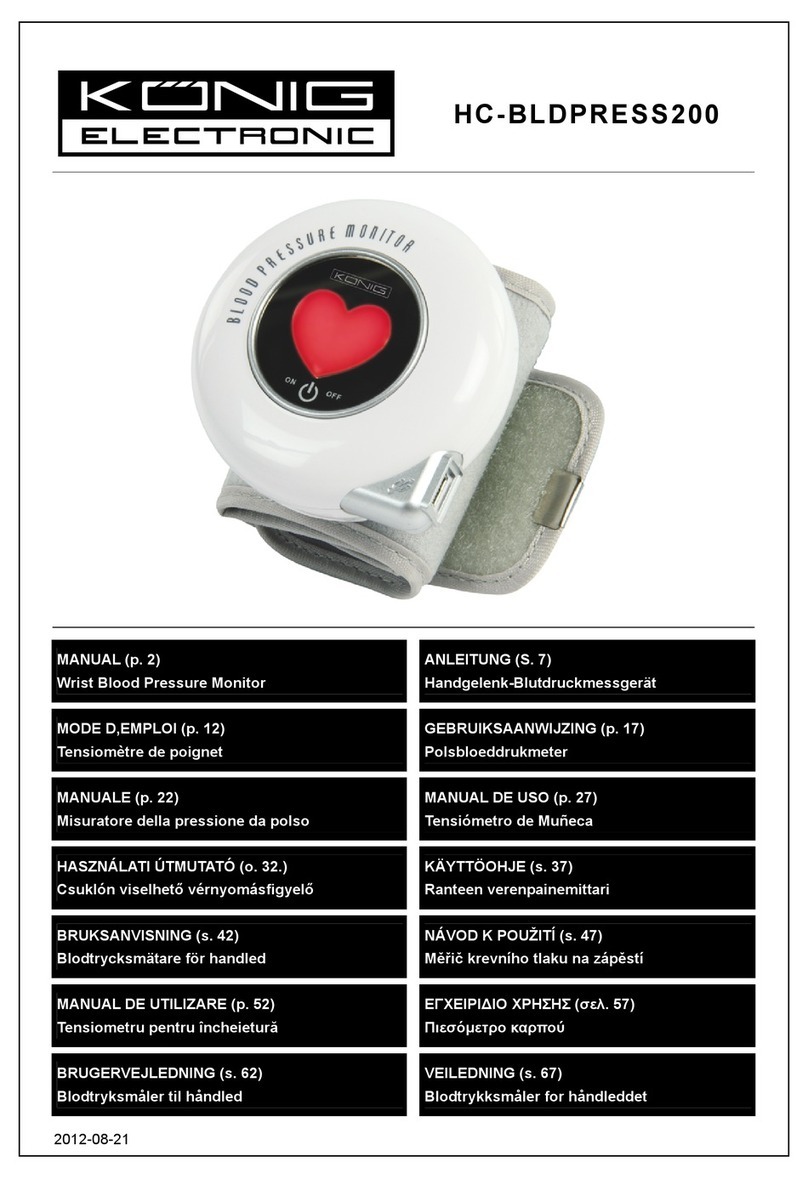
4. Connecting the cuff to the monitor
Insert the cuff tubing connector into the socket
in the left side of the monitor. Make certain that the
connector is completely inserted to avoid air leakage
during blood pressure measurements.
Avoid compression or restriction of the connection tubing during
measurement, which may cause ination error, or harmful injury due to
continuous cuff pressure.
5. Applying the cuff
a. Pulling the cuff end through the medal loop
(the cuff is packaged like this already), turn it
outward (away from your body) and tighten it
and close the Velcro fastener.
b. Place the cuff around a bare arm 1-2cm above
the elbow joint.
c. While seated, place palm upside in front of you on
a at surface such as a desk or table. Position the air
tube in the middle of your arm in line with your
middle nger.
c. The middle of the cuff should be at the level of the
right atrium of the heart.
Lying Down Measurement
a. Lie on your back.
b. Place your arm straight along your side with your
palm upside.
c. The cuff should be placed at the same level as your heart.
7. Taking your blood pressure reading
a. After applying the cuff and your body is in a comfortable position, press the
“START” button. A beep is heard and all display characters are shown for
self-test. See Picture 7-1. Please contact the service center if segment is
missing.
Picture 7-1 Picture 7-2 Picture 7-3 Picture 7-4 Picture 7-5
IMPORTANT INFORMATION .............................................................................3
CONTENTS AND DISPLAY INDICATORS .........................................................4
INTENDED USE.................................................................................................5
CONTRAINDICATION........................................................................................5
PRODUCT DESCRIPTION.................................................................................6
SPECIFICATIONS..............................................................................................7
NOTICE .............................................................................................................9
SETUP AND OPERATING PROCEDURES ......................................................12
1. Battery loading ............................................................................................12
2. Clock and date adjustment .........................................................................13
3. Voice setting ................................................................................................14
4. Connecting the cuff to the monitor .............................................................15
5. Applying the cuff .........................................................................................15
6. Body posture during measurement.............................................................16
7. Taking your blood pressure reading ............................................................17
8. Displaying stored results.............................................................................19
9. Deleting measurements from the memory..................................................21
10. Assessing high blood pressure for adults .................................................21
11. Technical alarm description.......................................................................23
12. Troubleshooting (1)....................................................................................24
13. Troubleshooting (2)....................................................................................25
MAINTENANCE...............................................................................................27
EXPLANATION OF SYMBOLS ON UNIT.........................................................28
ELECTROMAGNETIC COMPATIBILITY INFORMATION .................................30
WARRANTY INFORMATION ...........................................................................35
IMPORTANT INFORMATION
Normal blood pressure fluctuation
All physical activity, excitement, stress, eating, drinking, smoking, body posture
and many other activities or factors (including taking a blood pressure
measurement) will inuence blood pressure value. Because of this, it is mostly
unusual to obtain identical multiple blood pressure readings.
Blood pressure uctuates continually ----- day and night. The highest value
usually appears in the daytime and lowest one usually at midnight. Typically,
the value begins to increase at around 3:00AM, and reaches to highest level
in the daytime while most people are awake and active.
Considering the above information, it is recommended that you measure
your blood pressure at approximately the same time each day.
Too frequent measurements may cause injury due to blood ow interference,
please always relax a minimum of 1 to 1.5 minutes between measurements
to allow the blood circulation in your arm to recover. It is rare that you obtain
identical blood pressure readings each time.
NOTICE
1. Read all of the information in the operation guide and any other literature
in the box before operating the unit.
2. Stay still, calm and rest for 5 minutes before blood pressure measurement.
3. The cuff should be placed at the same level as your heart.
4. During measurement, neither speak nor move your body and arm.
5. Measuring on same arm for each measurement.
6. Please always relax at least 1 or 1.5 minutes between measurements to
allow the blood circulation in your arm to recover. Prolonged over-ination
(cuff pressure exceed 300 mmHg or maintained above15 mmHg for longer
than 3 minutes) of the bladder may cause ecchymoma of your arm.
7. Consult your physician if you have any doubt about below cases:
1) The application of the cuff over a wound or inammation diseases;
2) The application of the cuff on any limb where intravascular access
or therapy, or an arterio-venous (A-V) shunt, is present;
3) The application of the cuff on the arm on the side of a mastectomy;
4) Simultaneously used with other monitoring medical equipments on the
same limb;
5) Need to check the blood circulation of the user.
8. This Electronic Sphygmomanometers is designed for adults and
should never be used on infants or young children. Consult your phy-
sician or other health care professionals before use on older children.
9. Do not use this unit in a moving vehicle, This may result in erroneous mea-
surement.
10. Blood pressure measurements determined by this monitor are equivalent
to those obtained by a trained observer using the cuff/stethoscope
auscultation method, within the limits prescribed by the American National
Standard Institute, Electronic or automated sphygmomanometers.
11. Information regarding potential electromagnetic or other interference
between the blood pressure monitor and other devices together with advice
regarding avoidance of such interference please see part ELECTROMA-
GNETIC COMPATIBILITY INFORMATION.
12. If Irregular Heartbeat (IHB) brought by common arrhythmias is detected
in the procedure of blood pressure measurement, a signal of will be
displayed. Under this condition, the Electronic Sphygmomanometers can
keep function, but the results may not be accurate, it’s suggested that you
consult with your physician for accurate assessment.
There are 2 conditions under which the signal of IHB will be displayed:
1) The coefcient of variation (CV) of pulse period >25%.
2) The difference of adjacent pulse period≥0.14s, and the number of such
pulse takes more than 53 percentage of the total number of pulse.
13. Please do not use the cuff other than supplied by the manufacturer,
otherwise it may bring biocompatible hazard and might result in
measurement error.
CONTENTS AND DISPLAY INDICATORS
INTENDED USE
Fully Automatic Electronic Sphygmomanometer is for use by medical
professionals or at home and is a non-invasive blood pressure measurement
system intended to measure the diastolic and systolic blood pressures and
pulse rate of an adult individual by using a non-invasive technique in which
an inatable cuff is wrapped around the upper arm. The cuff circumference
is limited to 22cm-42cm (approx. 8 21/32”-16 17/32”).
CONTRAINDICATION
It is inappropriate for people with serious arrhythmia to use this
Electronic Sphygmomanometer.
14. The monitor might not meet its performance specications or cause
safety hazard if stored or used outside the specied temperature and
humidity ranges in specications.
15. Please do not share the cuff with other infective person to avoid
cross-infection.
16. This equipment has been tested and found to comply with the limits for a
Class B digital device, pursuant to part 15 of the FCC Rules. These limits
are designed to provide reasonable protection against harmful interference
in a residential installation. This equipment generates, uses and can radiate
radio frequency energy and, if not installed and used in accordance with
the instructions, may cause harmful interference to radio communications.
However, there is no guarantee that interference will not occur in a particular
installation. If this equipment does cause harmful interference to radio or
television reception, which can be determined by turning the equipment off
and on, the user is encouraged to try to correct the interference by one or
more of the following measures:
- Reorient or relocate the receiving antenna.
- Increase the separation between the equipment and receiver.
- Connect the equipment into an outlet on a circuit different from that to
which the receiver is connected.
- Consult the dealer or an experienced radio/TV technician for help.
SETUP AND OPERATING PROCEDURES
1. Battery loading
a. Open battery cover at the back of the monitor.
b. Load four “AAA” size batteries. Please pay attention to polarity.
c. Close the battery cover.
When LCD shows battery symbol , replace all batteries with new ones.
Rechargeable batteries are not suitable for this monitor.
Remove the batteries if the monitor will not be used for a month or more to
avoid relevant damage of battery leakage.
Avoid the battery uid to get in your eyes. If it should get in your eyes,
immediately rinse with plenty of clean water and contact a physician.
The monitor, the batteries and the cuff, must be disposed of according to
local regulations at the end of their usage.
PRODUCT DESCRIPTION
Based on Oscillometric methodology and silicon integrated pressure sensor,
blood pressure and pulse rate can be measured automatically and
non-invasively. The LCD display will show blood pressure and pulse rate.
The most recent 4x30 measurements can be stored in the memory with date
and time stamp. The voice function will ease the operation. The Electronic
Sphygmomanometers corresponds to the below standards: IEC 60601-1:2005
+A1:2012(E)/EN 60601-1:2006/A11: 2011 (Medical electrical equipment --
Part 1: General requirements for basic safety and essential performance),
IEC60601-1-2:2007/EN 60601-1-2:2007 /AC:2010 (Medical electrical
equipment -- Part 1-2: General requirements for basic safety and essential
performance - Collateral standard: Electromagnetic compatibility -
Requirements and tests), IEC80601-2-30:2009+AMD1:2013/EN 80601-
2-30:2010/A1:2015(Medical electrical equipment – Part 2-30: Particular
requirements for the basic safety and essential performance of automated
non-invasive sphygmomanometers)EN 1060-1: 1995 + A2: 2009 (Non-invasive
sphygmomanometers - Part 1: General requirements), EN 1060-3: 1997 +
A2: 2009 (Non-invasive sphygmomanometers - Part 3: Supplementary
requirements for electro-mechanical blood pressure measuring systems).
14. Environmental temperature for storage and transport: -20°C~50°C
(-4°F~122°F)
15. Environmental humidity for storage and transport: ≤85%RH
16. Environmental pressure: 80kPa-105kPa
17. Battery life: Approx 100 times.
18. All components belonging to the pressure measuring system, including:
Pump,Valve, LCD, Cuff, Sensor
Note: These specications are subject to change without notice.
d. The cuff should t comfortably, yet snugly around your arm. You should be
able to insert one nger between your arm and the cuff.
Note:
1. Please refer to the cuff circumference range in “SPECIFICATIONS” to make
sure that the appropriate cuff is used.
2. Measuring on same arm each time.
3. Do not move your arm, body, or the monitor and do not move the rubber
tube during measurement.
4. Stay quiet, calm for 5 minutes before blood pressure measurement.
5. Please keep the cuff clean. If the cuff becomes dirty, remove it from the
monitor and clear it by hand in a mild detergent, then rinse it thoroughly in
cold water. Never dry the cuff in clothes dryer or iron it. Clean the cuff after
the usage of every 200 times is recommended.
6. Body posture during measurement
Sitting Comfortably Measurement
a. Be seated with your feet at on the oor, and don’t
cross your legs.
b. Place palm upside in front of you on a at surface
such as a desk or table.
b. Then the current memory bank (U1, U2, U3 or U4) is shown. See picture
7-2. Press “MEM” button to change over to other bank. Conrm your
selection by pressing “START” button. The current bank can also be
conrmed automatically after 5 seconds with no operation.
c. If the monitor has stored results, the LCD will momentarily display the
most recent one. If no result has been stored, zero will appear on LCD.
See Picture 7-3.
d. If the voice function is switched on, the monitor will speak out measurement
tips.
e. Then the monitor starts to seek zero pressure. See picture 7-4.
f. Then the monitor inates the cuff until sufcient pressure has built up for a
measurement. Then the monitor slowly releases air from the cuff and carries
out the measurement. Finally the blood pressure and pulse rate will be
calculated and displayed on the LCD screen. The blood pressure
classication indicator and Irregular heartbeat symbol (if any) will blink on
the screen. If the voice function is on, it will announce the measurement
result. The result will be automatically stored in the monitor. See Picture 7-5.
g. After measurement, the monitor will turn off automatically after 1 minute of
no operation. Alternatively, you can press the “START” button to turn off the
monitor manually.
h. During measurement, you can press the “START” button to turn off the
monitor manually.
3. Voice setting
a. Voice language setting: In clock mode, you can select the voice language
by keeping on press the button “MEM”. Now LCD blink “L0”, “L1”, “L2” …
“Ln” (n means the number of language) circularly. “L0” represents closing
voice function, “L1” represents language 1, “L2” represents language
2,…,“Ln” represents language n, and so on. You can select the wanted
language by releasing button “MEM” when display the corresponding
language code.
Picture 3-1 Picture 3-2
b. Voice volume setting: Once you have selected a language, keeping on
pressing the button “MEM” again. A column of bar will appear on the left
side of the LCD. The higher the bars, the louder the volume. Release button
“MEM” at your desirable volume for conrmation.
SPECIFICATIONS
1. Product name: Arm Blood Pressure Monitor
2. Model: 32777 / KD-5920
3. Classication: Internally powered, Type BF applied part, IP20, No AP
or APG, Continuous operation
4. Machine size:
Approx.150 mm × 95 mm × 41 mm (5 29/32” x 3 3/4” x 1 5/8”)
5. Cuff circumference: 22-30 cm (8-11”), 30-42 cm (11-16”) optional,
42-48 cm (16-18.2”) optional
6. Weight: Approx. 235 g (8 9/32 oz.) (exclude batteries)
7. Measuring method: Oscillometric method, automatic ination and
measurement
8. Memory volume: 4×30 times with time and date stamp
9. Power source: batteries: 4×1.5 V SIZE AAA
10. Measurement range:
Cuff pressure: 0-300 mmHg
Systolic: 60-260 mmHg
Diastolic: 40-199 mmHg
Pulse rate: 40-180 beats/minute
11. Accuracy:
Pressure: ±3 mmHg
Pulse rate: ±5%
12. Environmental temperature for operation: 10°C~40°C (50°F~104°F)
13. Environmental humidity for operation: ≤85% RH
2. Clock and date adjustment
a. Once you install the battery or turn off the monitor, it will enter Clock Mode,
and LCD will display time and date.
b. While the monitor is in Clock Mode, press the “START” and “MEM” button
simultaneously for two seconds, the month will blink at rst. Press the
button “START” repeatedly, the day, hour and minute will blink in turn. While
the number is blinking, press the button “MEM” to increase the number.
Keep on pressing the button “MEM”, the number will increase fast.
Picture 2-1 Picture 2-2 Picture 2-3 Picture 2-4 Picture 2-5 Picture 2-6
c. You can turn off the monitor by pressing “START” button when the minute is
blinking, then the time and date is conrmed.
d. The monitor will turn off automatically after 1 minute of no operation with
the time and date unchanged.
e. Once you change the batteries, you should readjust the time and date.
JOLLY DIGITAL BLOOD PRESSURE MONITOR
2
3
4
5
6
9
10
11
12
8
7
15
16
17
18
14
13
ATTENTION:
The operators must carefully read
and completely understand the present manual
before using the product.
PROFESSIONAL MEDICAL PRODUCTS
Operation Guide
Rubber tube
Pulse
Deate the remnant air
Low battery
Irregular heartbeat symbol
START/STOP button
Cuff tubing
connector
Gima S.p.A.
Via Marconi, 1 - 20060 Gessate (MI) Italy
www.gimaitaly.com


